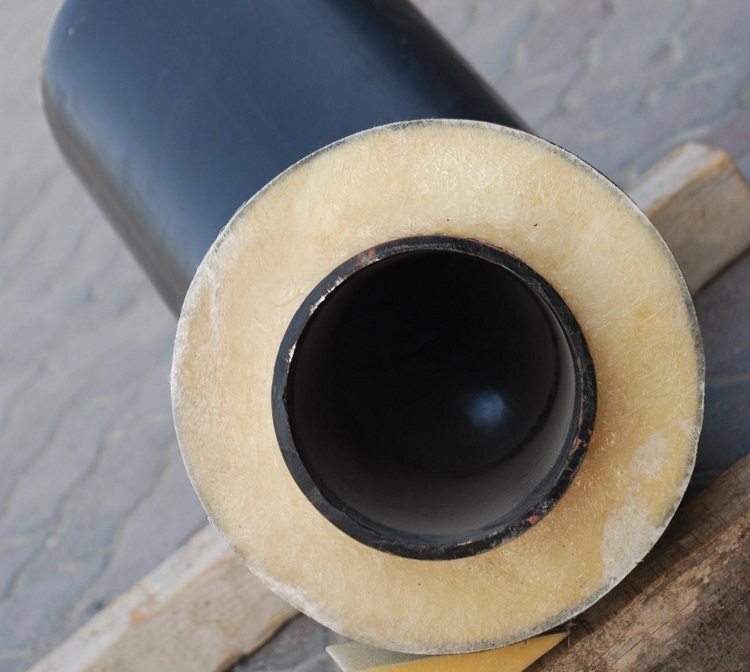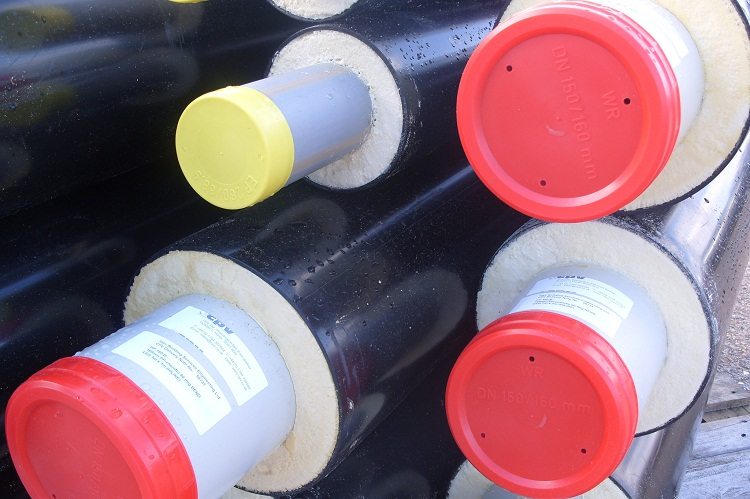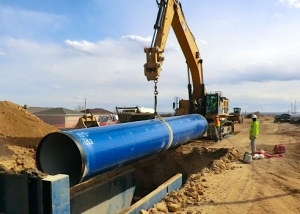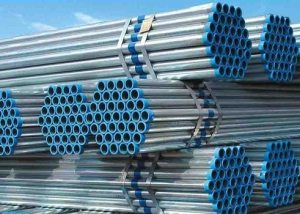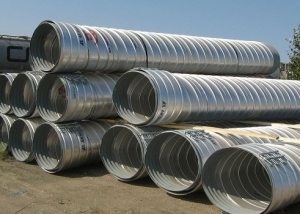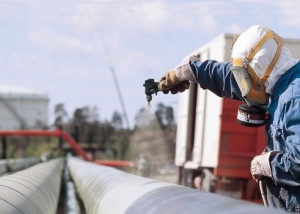Steel pipe in isolation PPU PE is produced according to state standard 30732 and is intended for use in networks where the maximum degree of protection of the substance pumped through the channel from external influences is required. A pipeline assembled from such products is characterized by minimal heat loss. Channels in isolation with a PE sheath are used for underground installation and are necessarily equipped with SODK indicator conductors.
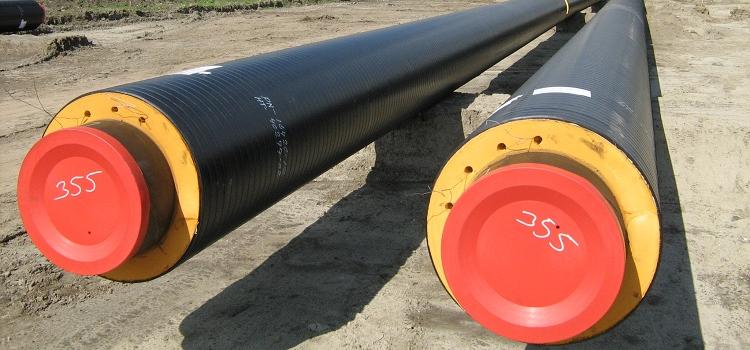
PE pipes in polyurethane foam insulation - is a modern material for the installation of heating systems and other highways
Content
Polyurethane foam as a material
The PPU PE pipe as a heat-insulating material has a polyurethane foam layer. It is characterized by a low coefficient of thermal conductivity (at the level of 19-28 mW / m * K). In the general case, for pipes (St, PE), PUF is a non-meltable thermosetting plastic with a cellular structure.
About 97% of its volume is occupied by pores and cavities filled with gas with very low thermal conductivity (the proportion of closed pores is from 90 to 95 percent). The remaining 3% of the PUF volume is a solid material that forms a frame of walls, ribs, and gives it mechanical strength.
Polyurethane foam is a two-component system. It consists of:
- a polyol as one component containing catalysts, polyols, stabilizers, blowing agent;
- isocyanate component containing PMDI (polymer diphenylmethanediisocyanate).
This material is one of the most effective heat insulators used in the modern construction of pipelines for oil, heating, gas, ceilings, floors, walls, walling, etc.
Note! Polyurethane foam is characterized by a significant density range: 40-200 kg / m3. This allows the use of PPU as a thermal insulation of floors.
Filling hard PPU is a foam material. It is obtained in the form of blocks in accordance with the size of the injection molds. Shrink tolerance value is 4 cm.
Stages of manufacturing products in polyurethane foam insulation
The manufacturing process of channels in polyurethane foam insulation can be divided into eight technological steps, each of which is carried out in accordance with regulatory documents:
- Quality control of materials and raw materials.
- Preparation of the outer surface of the steel pipe.
- Establishment of SODK and centering elements.
- Pulling a steel product with centralizers and a UEC conductor into a waterproof sheath made of polyethylene.
- Temperature stabilization.
- Filling components PPU.
- Holding period.
- Quality control of finished products.
The main components for the production of channels and shaped elements in PPU are:
- pipes with an external cross-section of 5.7-102.0 centimeters, up to 12 meters long, which comply with GOST 8733, 10705, 550, 8731, 20295;
- steel transitions, bends, tees and other shaped products corresponding to GOST 17380, 17376, 17375, 17378;
- HDPE polyethylene sheaths of black color with high density of grades no lower than 80 (according to document 18599).
The heat loss indicators of pipes in polyurethane foam are reduced to the requirements of SNiP 2.04.14.
Description of the pipe production process
At the first stage, the steel pipe and polyethylene sheath are subject to control. In addition, documentation is checked (passports, certificates, etc.) for raw materials. In order to ensure normal adhesion of the PPU layer to the pipe, it is important to remove rust, scale, dust, greasy, oil stains and other contaminants from its surface.
Note! To do this, brush, bead-blasting, or shot-blasting, chemical treatment, or flame can be used.
At the next stage, along the entire length of the steel pipe, centralizers are installed at some distance from one another. They will hold the product in the center of the polyethylene sheath. The copper wire of SODK is laid through the ears of the centralizers.
Then, with the help of a track pulling device, the structure is placed in a waterproof PE shell. This ensures the equality of the distances between the steel and polyethylene pipe at any point. In this case, the insulated pipeline will be characterized by the same thickness of the PUF layer. Temperature stabilization is carried out in a special chamber, where the structure is heated to 23 degrees (for improved adhesion of polyurethane foam and steel surface).
At the next stage, casting flanges are installed at the ends of the product, on one of which there are openings for air exhaust and filling the foam with a high-pressure machine. When pouring, the pipes are placed at an angle of 1-15 degrees to the horizontal. Exposure of products is necessary to achieve maximum performance and adhesion.
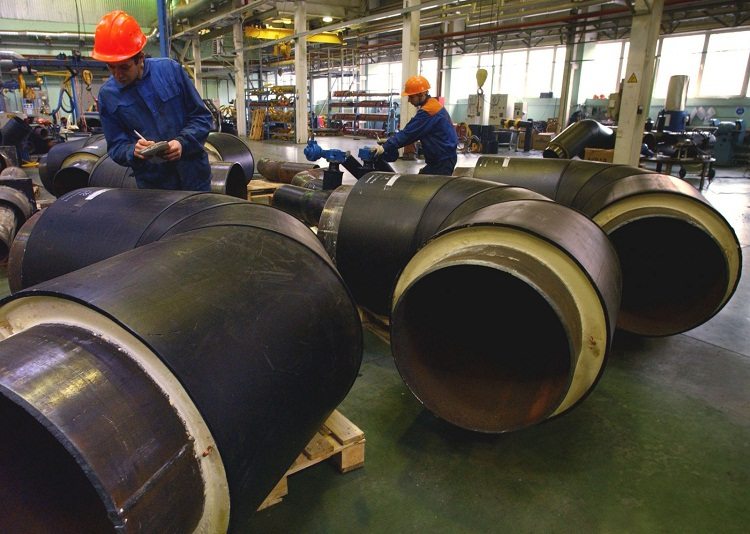
The production of pipes in polyurethane foam insulation and fittings implies strict control of the production process and the quality of finished products
Characteristics of polyethylene sheath
Pipes in polyurethane foam insulation with polyethylene sheaths are used for channel-free routing. For the manufacture of an outdoor structure, thermally illuminated PND is used, having a black color of grade 273-79 of the first and highest grade, and manufactured according to state standard 16338.
Polyethylene shells for the pipe located in the polyurethane foam insulation are produced with standard sizes 12.5-122.0 centimeters on extrusion lines. They reliably protect the insulated polyurethane foam steel channel from all sorts of influences in the soil, and also protect against external corrosion.
The shells should have a smooth surface with acceptable minor longitudinal stripes, undulations, be evenly cut without burrs at the ends. The main characteristics of the polyethylene channel in which the pipe is located in the foam insulation, are:
- elongation at break (relative): 350% (not less);
- change in the length of the PE shell after heating at 110 degrees: 3% (no more);
- resistance to tensile load of 4 thousand kPa, in a surfactant solution, at t = 80 ºС: 2 thousand hours (not less).
The welds of the shell pipe after filling the polyurethane foam should be airtight.
Processes for foaming and mixing PPU components
During the mixing of the components of the polyisocyanate and the polyol in the mixing compartment of the casting machine, a finely dispersed emulsion is formed. An increase in temperature and an increase in the viscosity of the mixture is explained by the exothermic reaction occurring in it. When the temperature reaches values greater than 25-28 degrees, intense foaming of the composition and gas formation begins, which is recorded as the start time for pipe insulation.
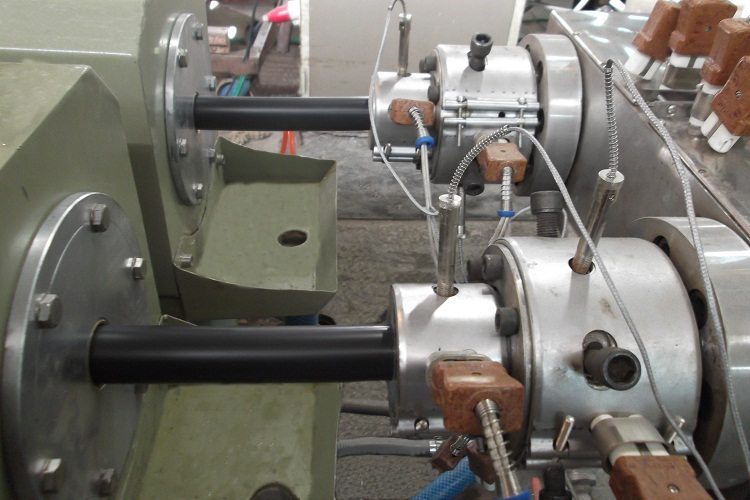
Shells for pipes are made by extrusion, but their walls are much thinner than conventional pipes, so when pouring foam, you must strictly follow the technology
The process of gas formation is stabilized by an increase in the viscosity of the polyurethane foam mixture and the presence of an organosilicon foam stabilizer in it. An additional growth of bubbles is also possible due to the reactions of the polyisocyanate and air moisture. Chemical processes lead to the emergence of a polymer structure (three-dimensional).The beginning of its formation is recorded as the gelation time.
Note! After this shaking, mechanical displacements, and other effects on the assembly of the structure can lead to the fact that the polyurethane foam layer of the hardening foam dramatically loses quality.
For this, pipes in thermal insulation are kept on racks. At this time, there are many unreacted groups in the polymer matrix. Further polymerization is characterized by the time of stickiness loss by the surface of the foam and the time it takes to fill the space between the shell and the pipe. After a few hours, chemical processes are completed, after a few days - mechanical relaxation.
Installation of thermally insulated products
Laying pipelines using insulated pipes consists of the following steps:
- stripping thermal insulation at a distance of not more than 30 cm from each of the edges of the product;
- welded joint;
- shrink sleeve installation on the pipe;
- filling the cavity under the coupling with foam;
- in situ deposition of the coupling by heating to obtain a tight joint.
The welded joint must be checked for strength using a portable flaw detector. When sealing joints, during welding, it is important to close the ends of the stripped insulation with some non-combustible material (for example, asbestos cloth), since both PE and PUF are combustible materials.
Often the installation of channels with pre-installed thermal insulation is performed by the horizontal drilling method. Shrink sleeves or tapes allow you to get a protective casing, which in its properties and qualities will not be inferior to the shell of the product. In addition to pipes, insulated bends are also available, having angles of 15-90 degrees, transitions, tee branches, tees (different and equal bores), elements with an output cable, P- and Z-shaped elements. All characteristics of auxiliary products for pipelines are prescribed in the standards.
Thus, a pipe in PPU PE insulation is a highly efficient product that allows you to quickly install the piping of a heating network, heating, hot water supply, laid underground.
